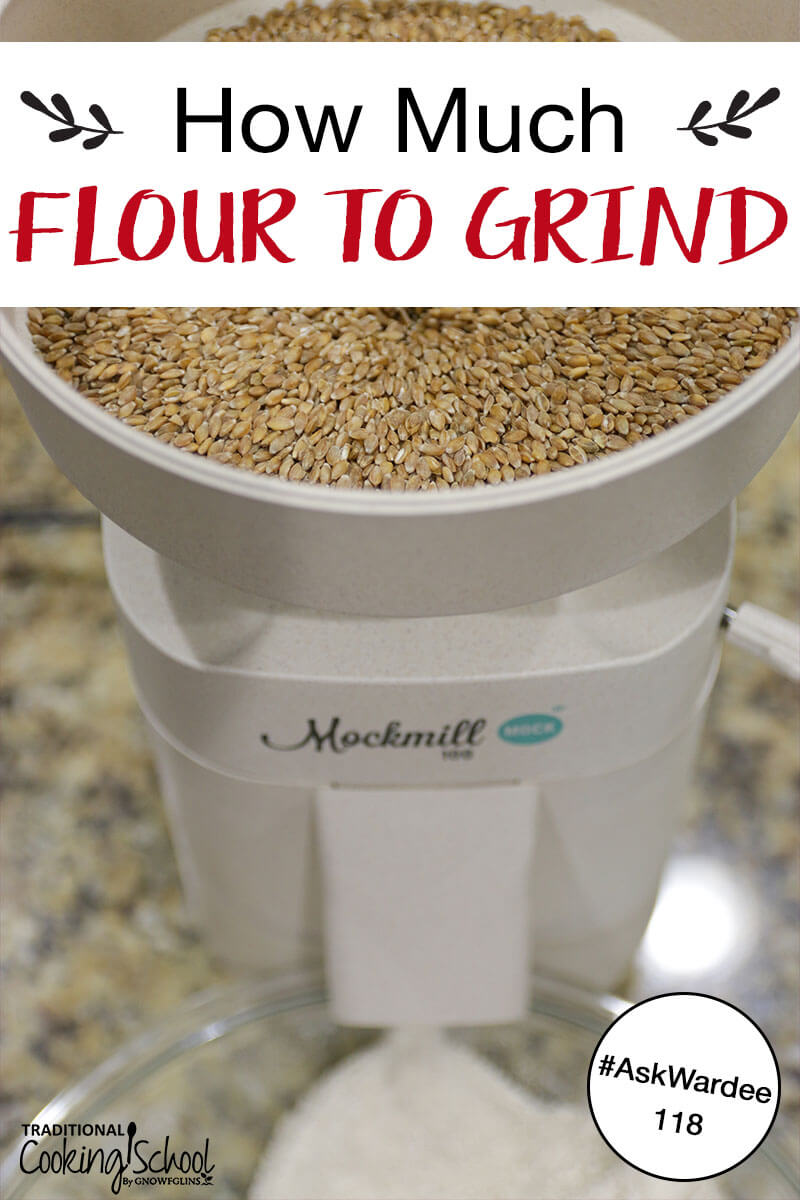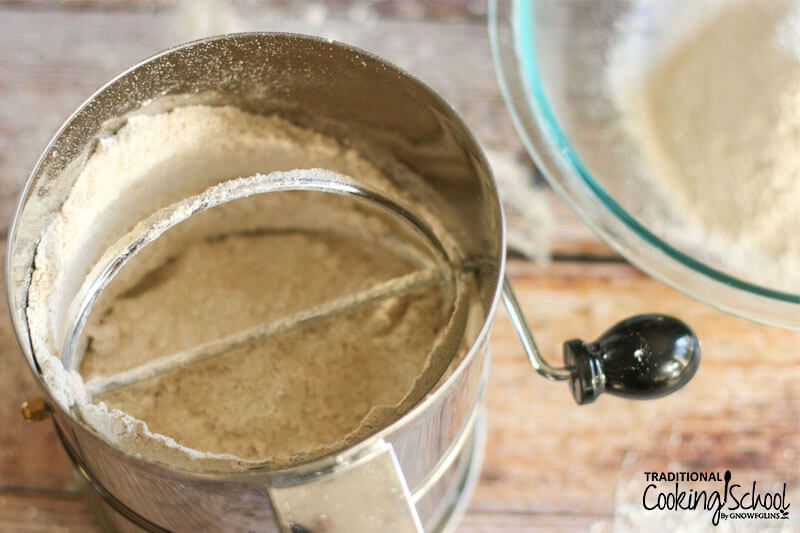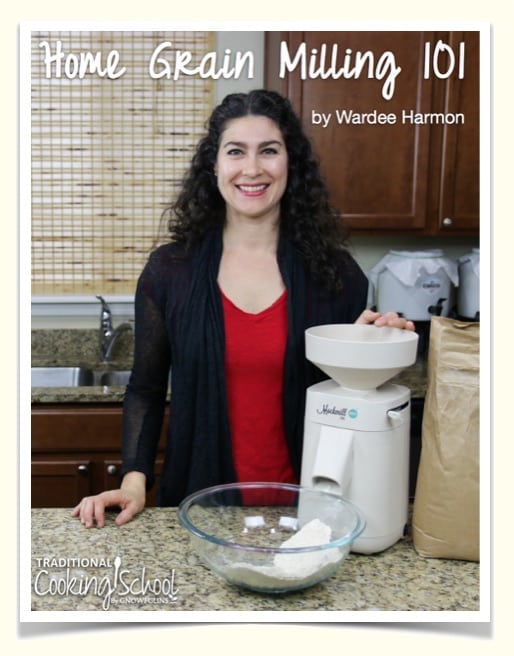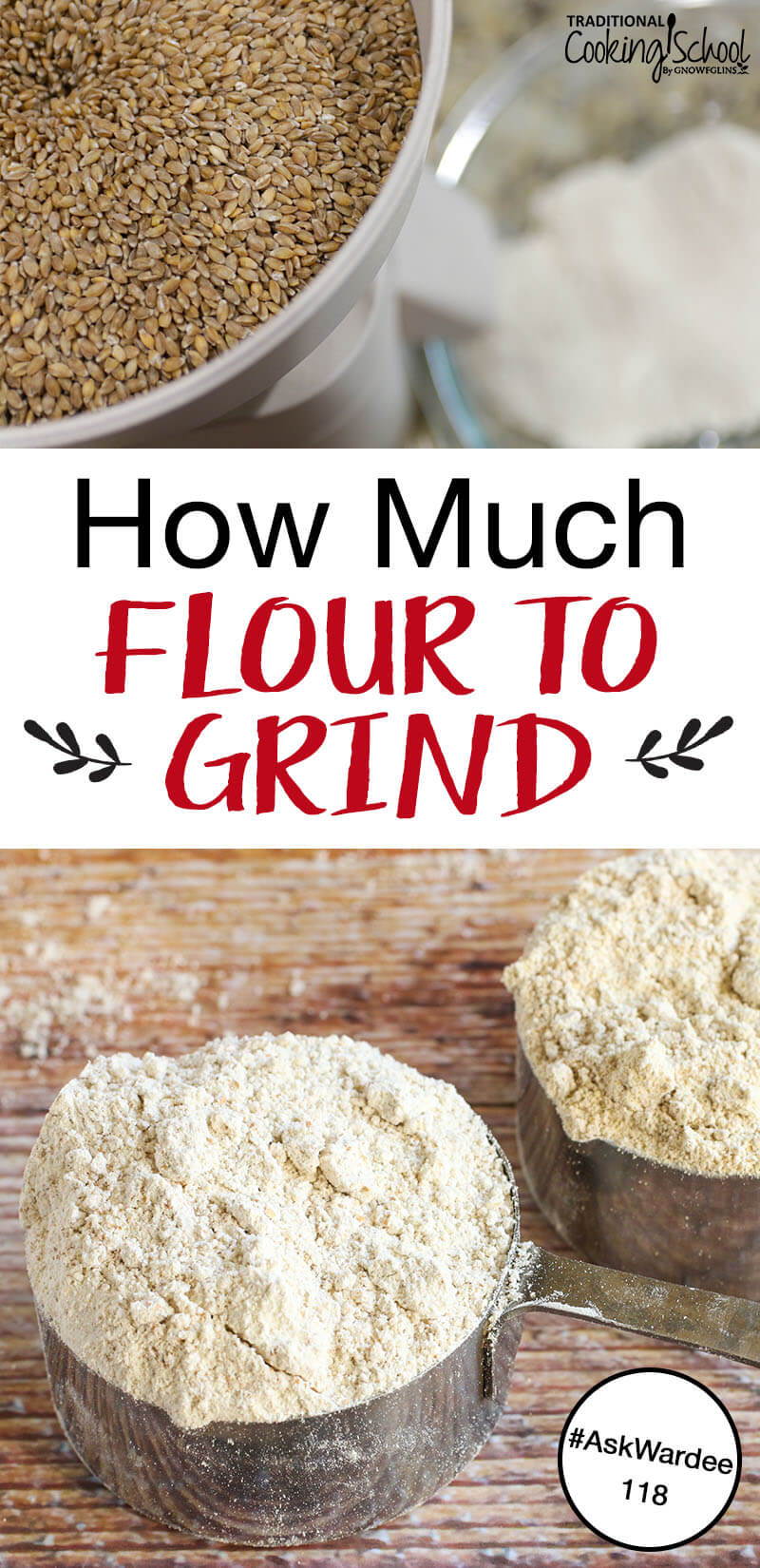
Want our FREE “Home Grain Milling 101” eBook? Click here to download the “Home Grain Milling 101” eBook for FREE!
You’ve got whole grain berries that you mill into fresh-ground flour yourself, yet the recipe you’re looking at calls for so many cups of flour…
So how do you know how many berries to grind to get that amount of flour?
Because fresh-ground flour is so much healthier and lighter, you want to get just the right amount so there’s none (or very little) leftover. So that next time you bake, you’ll be grinding more fresh instead of using leftover less healthy flour!
We have discussed how to use and store your flour, the basics of home grain milling, how to make gluten-free flours, how to use freshly ground flour in place of store-bought flour, and the other creative (and fun!) uses for a home grain mill.
And on today’s #AskWardee, I’m showing you how many berries to grind to get just the right amount of flour for your recipes!
Subscribe to #AskWardee on iTunes, Stitcher, YouTube, or the Podcasts app.xx
The Question: How Do I Know How Much Flour To Grind?
Mary B. asked:
I have recipes that call for so much flour, only I’m grinding my own flour from whole grain berries. How do I know how many berries to grind into flour? Is there a general rule for that?
Thanks for this question, Mary. 🙂
How Much Flour To Grind
It’s easy!
The general rule is, when measuring by volume:
However many cups of flour you need for the recipe, you grind half as many berries.
So…
Need 2 cups of flour? Grind 1 cup of berries.
Need 3 cups of flour? Grind 1-1/2 cups of berries.
And so on…
What Grains Does This Work For?
It works for nearly all grains you turn into flour, even sprouted berries.
You may find slight variations, but it’s usually close enough to adjust from the general rule.
Be sure to document your peculiarities as you go along!
Quick Tip: Grind Right Into Your Mixing Bowl!
Save an extra bowl!
You can place your Mockmill spout (my favorite home stone grain mill) right over your mixing bowl and grind the flour you need right into it.
Even if you’re adding flour a little at a time!
Add the first amount, proceed with the recipe, then grind more right into the bowl as needed.
If you are grinding flour into a mixer, like my Bosch, put the mill on a sturdy box or higher counter, positioning it over the mixing bowl.

What If You’re Going To Sift The Flour?
If you’re sifting the flour, you may need to grind a bit more to account for what’s sifted out.
The greater the quantity of flour in the recipe, the more extra you’ll need. Small amounts may only need a tiny bit extra ground.
Generally, to account for sifting, I use a rounded cup of berries for every 2 cups of sifted flour I need for baking.
What If You’re Measuring By Weight?
Some recipes call for grams of flour. What do you do then?
It’s easy! The grams stay the same, whether you’re measuring berries or flour.
So, if you need 720 grams of flour in a recipe (like if you were going to make my No-Knead Einkorn Sourdough Bread), you would measure out 720 grams of berries, and grind those.
What If You Do Have Extra?
Stick it in the fridge or freezer so it will retain nutrients longer.
This flour is perfect for feeding your sourdough starter!
We have free instructions for creating a sourdough starter here.
Any Other Questions?
That’s it! So simple!
If you have other questions, be sure to leave them in the comments!
My Favorite Grain Mill: The Mockmill
As you can tell from this series, the Mockmill is my favorite grain mill and the one I recommend! I’ve been recommending it for a year and lots of you have already gotten one in your homes. Mockmill tells me you’re very happy and I’m glad about that. 🙂
The Mockmill is a home stone grain mill, and it’s engineered and manufactured in Germany by Wolfgang Mock. He started making home grain mills back in the 1970s, so he’s been doing it for over 40 years. It’s estimated that nearly 70% of the stone mills out there are made by him.
This mill is super exciting because it contains the best features of Wolfgang Mock’s milling career, yet it’s much more affordable. The reason it’s more affordable is because this mill comes in a durable recycled material housing (instead of expensive wood).
I love the Mockmill because it produces super healthy freshly-ground flour with a really fine texture. It doesn’t warm the flour up like some mills do, so the flour is more nutritious. Finally, the flour yields wonderful, light bread!
This mill will also grind all grains, even gluten-free. It can even crack grains for porridge, and it has many other uses (like some spices, nuts, and seeds).
See How The Mockmill Works In This Video…
All the details — including the very affordable price and FREE SHIPPING — are on this page. By the way, it also comes as a KitchenAid attachment — very exciting for those who don’t want another appliance to take up any more room!
Also with your purchase of the Mockmill, you’ll get two fantastic eBooks from the Mockmill team: The Mockmill Farm Directory & Grain Milling Guide and The Mockmill Recipe Guide. Both of these eBooks are fabulous!
And, for a limited time… if you decide to purchase the Mockmill, I’m ALSO throwing in complimentary copies of both my Sourdough A to Z and Einkorn Baking eBook and Video Packages. They’re each worth $64 for a total of $128 in additional bonuses from me.
To claim your extra free bonuses from me after purchasing the Mockmill, just go to tradcookschool.com/millbonus. Have your order # handy, because you’ll need it to claim the two free eBook packages! (Your bonuses from Mockmill will come from them.)
 Want our FREE “Home Grain Milling 101” eBook? Click here to download the “Home Grain Milling 101” eBook for FREE!
Want our FREE “Home Grain Milling 101” eBook? Click here to download the “Home Grain Milling 101” eBook for FREE!
Helpful Links
- The Mockmill — my favorite and recommended (affordable) home stone grain mill — Hurry! The limited time offer to get my eBook packages valued at $128 won’t last long!
- Claim your FREE ($128 value) bonuses from me with your purchase of the Mockmill here!
- 8-cup hand-crank sifter
- Free “Home Grain Milling 101” eBook — our entire 4-part series combined into a single, FREE download from me!
- Differences Between Nutrimill And Mockmill #AskWardee 120
- Buckwheat Flour 101: Choosing, Milling Flour, Sprouting, Recipes & More! #AskWardee 141
- Milling Soft Wheat In A Grain Mill
- How To Simply & Easily Clean Your Mockmill Grain Mill #AskWardee 119
- Do Sprouting, Culturing, Or Sourdough Reduce Carbs? AW905
- FREE Webclass: Baking With Fresh-Ground Flour
- FREE No-Knead Sourdough Einkorn Bread Recipe
- FREE Sourdough Starter Instructions
- Why I <3 Einkorn — in case you want to know why we bake with the healthier 5,000 year-old wheat called einkorn!
- Where To Buy Einkorn
What Is The #AskWardee Show?
The #AskWardee Show is the live weekly show devoted to answering your niggling questions about Traditional Cooking: whether it’s your sourdough starter, your sauerkraut, preserving foods, broth, superfoods or anything else to do with Traditional Cooking or your GNOWFGLINS lifestyle.
I share tips and resources, plus answer your questions about Traditional Cooking!
The Details
When: Wednesdays at 10am Pacific / 1pm Eastern
Where: Traditional Cooking School on Facebook Live or @TradCookSchool on Instagram Live
What If You Can’t Make It?
Don’t worry. You can catch the replays or listen to the podcast!
- Come back here to AskWardee.TV; all replays will be up within hours of airing live; the print notes are always posted at the same time I go live.
- Go to Traditional Cooking School on Facebook to view the Facebook Live replay or go to @TradCookSchool on Instagram on your phone or tablet (Instagram recording only lasts 24 hours).
- Subscribe to the #AskWardee podcast on iTunes, Stitcher, YouTube, or the Podcasts app. While you’re there, be sure to leave a rating and review!
Want To Get YOUR Question Answered?
Here’s how to submit your question. If we answer it on #AskWardee, you’ll get a gift!
- Tweet your question to @TradCookSchool on Twitter; use hashtag #AskWardee
- Send an email to wardee at AskWardee dot tv — add #AskWardee to your email so I know it’s for the show
Please do NOT add future questions for #AskWardee to the comments of this post because they might get missed!
Do you bake with fresh-ground flour? Have you already figured out the perfect wheat berries to flour conversion rate? Share your thoughts and/or tips in the comments!
...without giving up the foods you love or spending all day in the kitchen!

2 free books:
Eat God's Way
Ditch the Standard American Diet, get healthier & happier, and save money on groceries...
We only recommend products and services we wholeheartedly endorse. This post may contain special links through which we earn a small commission if you make a purchase (though your price is the same).





Wow! No dust like the Nutrimill!
I have my original Magic Mill
3 plus! I hope it’s good enough! Hardly used it in the 90’s it’s ready to go for Einkorn Flour!
How exciting to put it back into use! Enjoy grinding your own flour. 🙂
~Peggy, TCS Customer Success Team
How long can you store extra flour in freezer?
Hi, Sandy: Wardee recommends storing flour in the freezer for up to six months. —Sonya, TCS Customer Success Team
You say 1 cup of berries equals 2 cups flour. I measure by cups or grams but I store by pounds. Does 50# of wheatberries produce. 50# of ground flour or 100# ground flour? I need to figure out how many pounds I need per year to store for the future
Hi, Hershell: Because we’re talking about two different measurements — volume and weight — I think you’d need to know how many cups of grain equal 1 pound, and then multiply by 50 to know how many cups of grain you’d have. Then double that number to know how many cups of flour you’d have. So the volume is doubled, but I’m not sure that works for the weight. I hope that makes sense! —Sonya, TCS Customer Success Team
Hello! I’m new to this site. Great info! I have a question about wheat berries. I went to purchase some but noticed there are different kinds, like red and white. Does it matter if I wanted to use a mill to make it into flour? The one video I watched said you could also use a high speed blender. Is this accurate? Thank you so much!
Hi, Marie,
Thank you! The red wheat berry will be a dense wheatier berry than the white. It is all about what you prefer and looking for in your flour. We prefer to work with ancient grains such as spelt or einkorn. You can use a high-speed blender but you have to be careful it doesn’t get too hot and it doesn’t grind as well as a mill. We prefer the Mockmill. ~Peggy, TCS Customer Success Team
Thank you Peggy. What about a coffee grinder? Or a food processor? Would either work better than a blender? I’ll get a mill if needed, but I have so many kitchen appliances, it would be nice to see if I could use something that I already own. ~Marie
One more question. If I stick with the white, I notice there are two choices on the website I am looking at. Soft and hard. Which makes better flour? Thanks again.
Hi, Marie.
You can use a medium to high-powered coffee grinder however you would need to likely grind multiple times and, unless you have a commercial-size grinder, you’d only be able to do very small batches.
“Soft” refers to wheat with a low gluten content, while “hard” refers to wheat with a high gluten content. The gluten in flours made with hard wheat give bread dough more elasticity, which results in bread that holds its shape when baked.
~Danielle, TCS Customer Success Team
Thank you so much!
Where do you purchase your einkorn berries?
Hi, Charon.
We have have a link above: http://tradcookschool.com/einkorn
~Danielle, TCS Customer Success Team